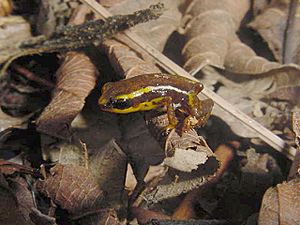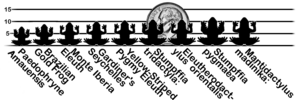Yellow-striped pygmy eleuth facts for kids
Quick facts for kids Yellow-striped pygmy eleuth |
|
|---|---|
 |
|
| Conservation status | |
| Scientific classification | |
| Synonyms | |
|
Phyllobates limbatus Cope, 1862 |
The yellow-striped pygmy eleuth (scientific name: Eleutherodactylus limbatus) is a tiny frog that lives in Cuba. It's also known as the yellow-striped dwarf frog because it's so small! This special frog belongs to a family called Eleutherodactylidae. You can find it in forests that are either quite wet (called mesic forests) or very dry (called xeric forests).
This little frog is known for its bright orange-yellow stripes. It's one of the smallest frogs in the world! An adult yellow-striped pygmy eleuth is usually less than 1.18 centimeters (about 0.46 inches) long from its nose to its tail end. Female frogs are just a tiny bit bigger than males.
The yellow-striped pygmy eleuth is part of a group of similar frogs found in Cuba. This group includes five other known species and at least one more that hasn't been officially named yet. Most of these related frogs are also very small and brightly colored. Some of them, like the Monte Iberia eleuth, even have special toxins (poisons) in their skin to warn predators.
What makes the yellow-striped pygmy eleuth special is how widespread it is across Cuba. The other tiny frogs in its group usually live in very small areas, mostly in the eastern part of the island.
Mating Calls and Reproduction
The yellow-striped pygmy eleuth has a very loud and strong mating call. Even though it's loud, it's super short! Each call lasts only about 6.9 to 24.8 milliseconds. That's faster than a blink! The call is also very high-pitched, like a tiny squeak. These frogs can call very quickly, up to 278 times in just one minute.
When it's time to lay eggs, female frogs have just one ovary. They lay one egg at a time. After the egg is laid, the female buries it in the ground. The egg then develops quickly underground until a tiny froglet hatches!
Where They Live: Habitat
You can find these tiny frogs in Cuba at different heights, from sea level up to about 1,150 meters (about 3,770 feet) high. They live in forests where the trees form a thick roof, blocking out a lot of sunlight. These can be forests that are quite moist (mesic) or very dry (xeric).
Even though these frogs are found across a total area of about 20,000 square kilometers (about 7,700 square miles), their homes are spread out in many small patches. This means their habitat is "fragmented." But don't worry, within these small areas, there are usually lots of yellow-striped pygmy eleuths!
See also
 In Spanish: Ranita Pigmea para niños
In Spanish: Ranita Pigmea para niños



